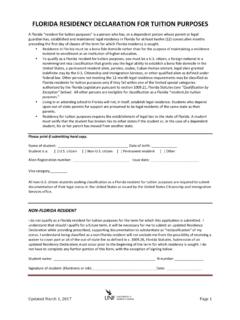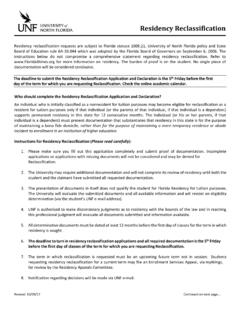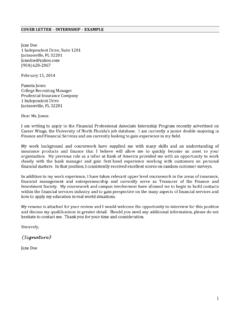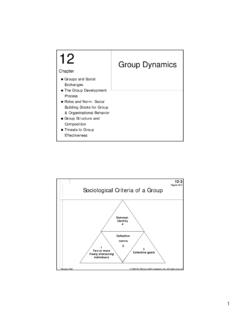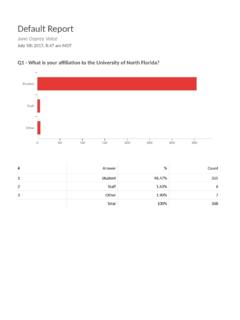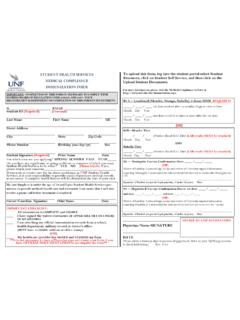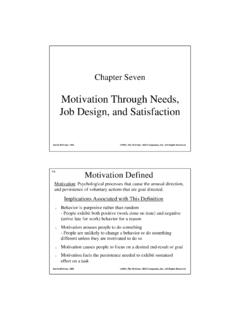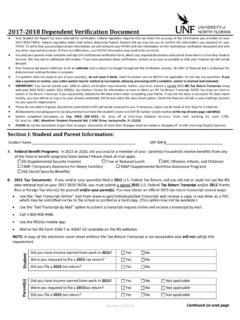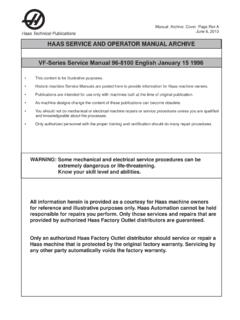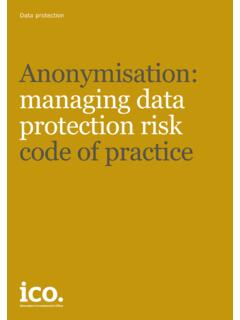Transcription of UNF - Coggin - University of North Florida
1 1 COURSE SYLLABUS TERM: Spring 2008 COURSE TITLE: Logistics/ supply chain management TRA 6157 (3 Semester Hours) COURSE DESCRIPTION: There is a great deal of confusion regarding exactly what supply chain management (SCM) involves. In fact, most people using the name supply chain management treat it as a synonym for logistics or as logistics that includes customers and suppliers. However, successful SCM requires cross-functional integration of key business processes within the firm and across the network of firms that comprise the supply chain . The challenge is to determine how to successfully accomplish this integration. The distinction between logistics and supply chain management is identified and a framework for SCM is presented. A class session will be devoted to each of the eight supply chain processes as well as to topics such as: the management components of supply chain management ; electronically linking the supply chain ; integrating supply chain strategy to corporate strategy; supply chain mapping; supply chain metrics; developing and implementing partnerships in the supply chain ; and, implementing supply chain management .
2 Prerequisites: MAN 6501 and ISM 6021, or permission of instructor. INSTRUCTOR: Dr. Robb Frankel OFFICE HOURS: Mondays and Wednesdays: 2:00pm - 4:00pm and by appointment. Appointments are preferred. REQUIRED TEXT: supply chain management : processes , Partnerships, Performance, Douglas M. Lambert (ed). The supply chain management Institute, FL. 2nd Edition 2006 Additional Reading Packet of Articles Handouts Other course materials including PowerPoint slides, cases, and outside readings and assignments will be made available in class and/or on Bbd. TEACHING SCHEDULE: COURSE CONTENT: This is a course in supply chain management (SCM), a term which denotes the integration of key business processes from end user through original suppliers for the purpose of adding value for the firm, its key supply chain members, to include customers and other stakeholders.
3 This course presents a framework for SCM that requires cross-functional integration of key business processes within the firm and across the network of firms that comprise the supply chain . This course approaches SCM from a managerial perspective and introduces concepts in a format useful for management decision making. Basic terms, concepts, and principles are examined in light of how they interrelate and interface within the firm and across the supply chain . Illustrations are taken from corporate applications of these concepts to show how supply chain management can be implemented. Topics covered include: 2 Topic Coverage in weeks Introduction to supply chain management The management components of supply chain management Eight supply chain processes Electronically linking the supply chain supply chain performance measurement Developing and implementing partnerships in the supply chain Implementing supply chain management Exams and presentations Total COURSE OBJECTIVES: The objectives of this course are to provide the student with: 1.
4 An understanding of the primary differences between logistics and supply chain management 2. An understanding of the individual processes of supply chain management and their interrelationships within individual companies and across the supply chain 3. An understanding of the management components of supply chain management 4. An understanding of the tools and techniques useful in implementing supply chain management 5. Knowledge about the professional opportunities in supply chain management . COURSE FORMAT: The teaching method will be a combination of seminar-type lectures and discussions, case work, and individual research. The lecture will cover the assigned topic, but will not necessarily cover the material as presented in the text. Lectures, class discussions and in-class exercises are not designed to reiterate the textbook, articles and/or other handout materials, especially with regard to presentation.
5 You are expected to attend all classes and to be prepared to discuss and/or apply assigned readings. Students will be called upon by name to discuss assigned topics and concepts. Students are also expected to participate in on-line discussion boards in Bb, team exercises, and case studies. QUIZZES: There are multiple quizzes planned for this course. The material for each quiz will cover any concepts already covered from the textbook, articles, handouts, class lecture and discussion, exercises, and speakers. Quizzes will be composed of short essay questions, fill-in-the-blank questions, and occasional multiple choice questions. The quizzes will be in-class or take-home, announced or unannounced - there will be no make-up quizzes, without a valid medical excuse, family emergency or pre-arranged instructor/student agreement. Take-home quizzes handed in late will be assessed a late point deduction that varies between 20%-25% per day.
6 It is the responsibility of the student to contact the instructor to review the results of a quiz. A student s request for the instructor to review a quiz grade must be done within one (1) week of the date when the quiz is returned in class. Point totals per quiz will vary considerably. A quiz might be worth as little as 5-10 points, or as much as 25-30 points. Longer, more comprehensive quizzes will be a take-home format, and announced one-two (1-2) weeks in advance and handed out one (1) week in advance of the due date. I strongly suggest that you stay current with the assigned readings it will make the quiz set-up/format a more enjoyable aspect of your life. INDIVIDUAL supply chain MAPPING EXERCISE: Each student will prepare a supply chain map for a company and one (1) of its products or services. The choice of company and product is the student s responsibility.
7 The map will illustrate the multiple tiers of appropriate suppliers and customers in that chosen company s supply chain . A write-up explaining the role of each of the relevant eight supply chain management processes discussed throughout this course will accompany the map. This exercise is designed to be an ongoing assignment; in other words, students will most likely be making additions and deletions to their map throughout the semester. Maps may be 3turned in during the semester for instructor evaluation/feedback/suggestions (without any grade being given), prior to the due date. The individual map is due no later than the beginning of class on April 2. CASES: Each student will prepare two (2) individual cases. The purpose of each case is to get you involved in the course material, and to help you to understand the supply chain issues by utilizing topics that make them realistic and relevant.
8 The specific requirements for each written case will be completely discussed at the appropriate points in time during the semester. Each case write-up will vary in length, typically from approximately 6-10 pages in length. Turning in a case late is not advisable as I will again assess a late grade point deduction that varies between 20%-25% per day. ABSTRACTS: Each student team will be required to prepare two one-page abstracts of refereed journal articles which discuss a topic relevant to the subject of supply chain management . Students selection of topic will be included in the grading scheme but some suggestions of appropriate topics are included below: Defining supply chain management The scope of supply chain management Example implementation of any of the eight key business processes supply chain /logistics distinctions Integrating the supply chain Outsourcing (3pls-client) relationships The supply chain strategy and corporate strategy interface Creating supply chain value supply chain Agility supply chain Information Systems supply chain metrics In order to ensure that students do not abstract the same articles, the rule of "first-come, first-served" will apply.
9 You may abstract a full-text, recent ( , within last 3 years) article downloaded from the Internet, as long as it is indeed full-text (complete with all tables, figures, and bibliography). In addition to submitting a hard copy, abstracts must be submitted to me (via e-mail to in MS Word. Use the following format for preparing your abstracts: Type your name in the upper right hand corner of the page. At the top of the page, in bold print, you should have the bibliographical entry for the article you are abstracting, in the following format: Bolumole, Yemisi A. (2001), The supply chain Role of Third-Party Logistics Providers, The International Journal of Logistics management ; Vol. 12, Number 2, pp. 87 -102 Following this, skip one line, and begin your abstract. It should summarize the main theme of the paper, outline the research method used, and review findings/results/benefits/conclusions.)
10 The text should be one page only (and not shorter than one entire page), single spaced, with one inch margins and a 12 point font. Attach a photocopy (or printed copy from an online source) of the article after the abstract. The printed copy should be on x 11 paper. Put a staple in the upper left corner. Do not provide a cover page or place your work in a folder. Do not quote directly, and do not use any headings. Do not skip lines between paragraphs; simply indent the next paragraph and proceed. Avoid any grammatical errors or misspelled words. Do not abstract a research "note," unless it is of considerable length ( , more than 5 pages or so). Do not abstract an article in a "magazine" instead of an academic journal. Do not select an article that is laden with mathematical notation, theorems, proofs, etc. Indicate precisely which topic or method from the list was discussed, and how that article made a contribution over and above previous work in the literature.

